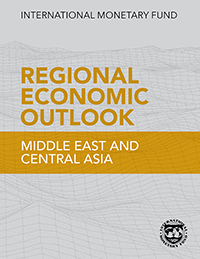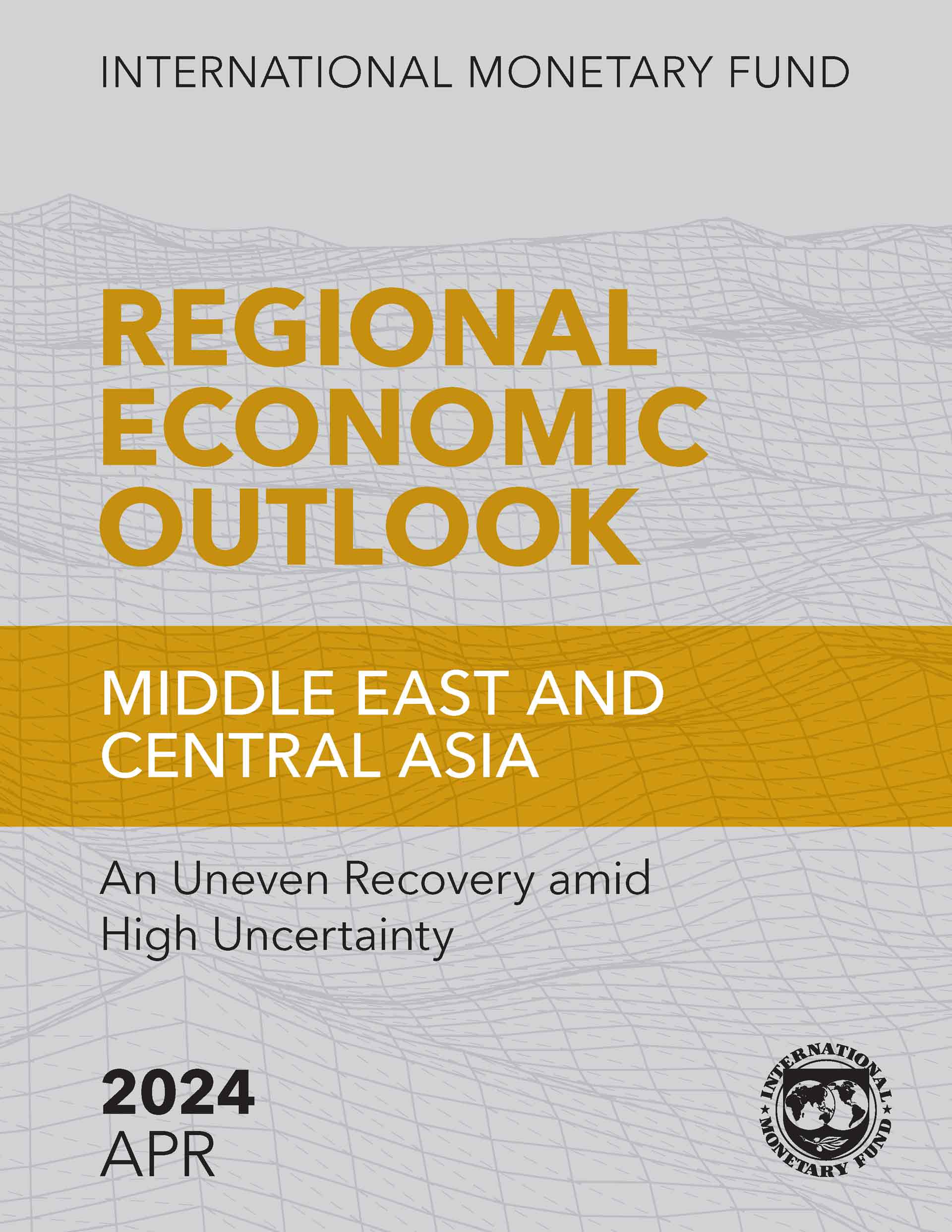Middle East and Central Asia
2025
October 21, 2025
Regional Economic Outlook for the Middle East and Central Asia, October 2025
Description:
Resilience amid Uncertainty: Will It Last? Economic growth in the Middle East and Central Asia was resilient in 2025 despite global uncertainty. But maintaining momentum will require cautious macroeconomic policies, and long-term reforms.
May 1, 2025
Regional Economic Outlook for the Middle East and Central Asia, May 2025
Description:
Charting a Path through the Haze Growth is projected to rise in the Middle East and North Africa in 2025 and 2026, but at a slower pace than anticipated in the October 2024 REO. Across the region, rising trade tensions and policy uncertainty are adding to the impact of conflicts and extended oil production cuts to weaken growth prospects. In the Caucasus and Central Asia, growth has been robust but is set to moderate to a more sustainable pace. Policymakers must adapt to the new environment, prioritizing macroeconomic stability and accelerating structural reforms to seize global opportunities.
2024
October 31, 2024
Regional Economic Outlook for the Middle East and Central Asia, October 2024: Navigating The Evolving Geoeconomic Landscape
Description:
Navigating the Evolving Geoeconomic Landscape The global economic landscape faces significant challenges, including from geoeconomic fragmentation. In the Middle East and North Africa and Caucasus and Central Asia regions, economies are facing shifting trade patterns while also dealing with frequent shocks from conflicts and climate change. Moreover, medium-term growth prospects have deteriorated over the past two decades and are projected to remain subdued. Decisive reforms are needed to place countries on the path to a more resilient and inclusive economic future.
April 18, 2024
Regional Economic Outlook for the Middle East and Central Asia, April 2024: An Uneven Recovery amid High Uncertainty
Description:
An Uneven Recovery amid High Uncertainty The Middle East and North Africa and the Caucasus and Central Asia regions are positively impacted by the resilience of the global economy. Lower global commodity prices and vigilant policy responses have helped ease inflation in most countries. However, uncertainty and risks have risen amid ongoing conflicts, shipping disruptions, and reduced oil production. This is leading to an uneven recovery across the Middle East and Central Asia, with growth rates varying this year. Policymakers need to ensure economic stability and debt sustainability while navigating geopolitical risks and improving medium-term growth prospects. Amid high uncertainty, it is essential that countries implement reforms to enhance their fundamentals, including by strengthening institutions. Additionally, countries can seize potential economic opportunities amid shifting trade patterns by reducing long-standing trade barriers, diversifying products and markets, and improving infrastructure.
January 31, 2024
Regional Economic Outlook: Middle East and North Africa
Description:
Conflict Compounding Economic Challenges
The conflict in Gaza and Israel is yet another shock to the Middle East and North Africa (MENA) region. It
is causing immense human suffering and exacerbating an already challenging environment for
neighboring economies and beyond. This Update covers economies in the MENA region and does not
discuss developments in Israel. Overall, the major factors weighing on regional growth in MENA are
(i) the impact of the conflict; (ii) oil production cuts (even as robust non-oil sector activity continues to
support growth in several oil exporters); and (iii) continued necessary tight policy settings in several
economies. Social unrest has also picked up. Projected growth in the MENA region this year is
downgraded by 0.5 percentage point to 2.9 percent (relative to the October 2023 Regional Economic
Outlook: Middle East and Central Asia), from already weak growth of 2.0 percent in 2023. Primarily driven
by the ongoing conflict in Sudan, average growth across low-income countries (LICs) in MENA is forecast
to remain negative this year, continuing the estimated sharp decline in 2023. Disinflation is expected to
continue in most MENA economies, although price pressures have proven persistent in some cases
because of country-specific factors.
The outlook for the MENA region is highly uncertain, and downside risks are resurgent. An escalation or
spread of the conflict beyond Gaza and Israel, as well as an intensification of the disruptions in the Red
Sea, could have a severe economic impact, including on trade and tourism.
The appropriate policy response will depend on countries’ exposure to the conflict, preexisting
vulnerabilities, and policy space. Crisis management and precautionary policies will be critical where the
impact is acute, or risks are elevated. Elsewhere, countries will need to continue to fortify buffers.
Monetary policy will need to remain focused on price stability, and fiscal policy should be tailored to
country needs and available fiscal space. Structural reforms remain critical to boosting growth and
strengthening resilience in both the near and longer terms.
2023
October 12, 2023
Regional Economic Outlook for the Middle East and Central Asia, October 2023
Description:
Building Resilience and Fostering Sustainable Growth Across the Middle East and Central Asia, the combined effects of global headwinds, domestic challenges, and geopolitical risks weigh on economic momentum, and the outlook is highly uncertain. Growth is set to slow this year in the Middle East and North Africa region, driven by lower oil production, tight policy settings in emerging market and middle-income economies, the conflict in Sudan, and other country-specific factors. In the Caucasus and Central Asia, although migration, trade, and financial inflows following Russia’s war in Ukraine continue to support economic activity, growth is set to moderate slightly this year.
May 3, 2023
Regional Economic Outlook for the Middle East and Central Asia
Description: The economies of the Middle East and Central Asia (ME&CA) proved resilient in 2022, despite a series of global shocks. However, this year—and potentially next—growth is expected to slow in the Middle East and North Africa (MENA) as tight policies to fight inflation, reduce vulnerabilities, and rebuild buffers start to dent economic activity in many countries, and agreed oil production cuts curb growth in oil exporters. Inflation is projected to remain persistent. The outlook for Caucasus and Central Asia (CCA) countries depends heavily on external factors, namely the impact of monetary tightening, growth in their main trading partners, the pace of private transfers, and inflows of migrants from Russia. Uncertainty is high, and risks to the baseline are tilted to the downside amid financial stability concerns—particularly in advanced economies amid contagion fears. Policy trade-offs are even more complex, and policymakers will need to calibrate the policy mix carefully to reduce core inflation without triggering financial stress and excessive tightening and continue to provide targeted fiscal support to vulnerable groups while preserving debt sustainability and financial stability. Tight monetary and fiscal policies across the region amid tight global financial conditions call for accelerating structural reforms to bolster potential growth and enhance resilience.
2022
October 12, 2022
Regional Economic Outlook for the Middle East and Central Asia, October 2022
Description: In a worsening global environment, economies in the Middle East and Central Asia (ME&CA) are being buffeted by a confluence of shocks: a global slowdown, high and volatile food and energy prices, faster and stronger-than-expected tightening of financial conditions, and the risk of fragmentation. The region’s emerging market and middle-income economies (EM&MIs) and low-income countries (LICs) are hit hard, with many facing curtailed access to market financing, while oil-exporting countries are being buffered by still-high energy prices. The adverse impact of Russia’s war in Ukraine on the Caucasus and Central Asia (CCA) has thus far been milder than expected. Still, the CCA’s strong ties to Russia entail substantial risks to the region’s outlook.
April 27, 2022
Regional Economic Outlook April 2022 Middle East Central Asia
Description: The war in Ukraine and sanctions on Russia are exacerbating the divergence in recovery prospects for the Middle East and Central Asia. Despite better-than-expected momentum in 2021, the economic environment in 2022 is defined by extraordinary headwinds and uncertainties, particularly for commodity importers, with higher and more volatile commodity prices, rising inflationary pressures, faster-than-expected monetary policy normalization in advanced economies, and a lingering pandemic.
2021
October 19, 2021
Regional Economic Outlook for the Middle East and Central Asia
Description: A fragile recovery continues in the Middle East and Central Asia region. The region has made good progress since the beginning of the year, but new challenges have emerged. They include a pandemic wave in countries with weak vaccination progress and rising inflation, which has contributed to declining monetary policy space, adding to the difficulties posed by limited fiscal policy space. Additionally, divergent recoveries and concerns about economic scarring persist. Inequities are also on the rise, and countries will need to tackle the pandemic’s impact on debt, labor markets, and the corporate sector. Countries will face difficult tradeoffs amid this challenging environment as they continue to manage the current crisis. Ramping up vaccine acquisition and distribution remains the most urgent short-term priority. Additional support should be well targeted, and central banks may need to raise interest rates if inflation expectations start to increase. Improving policy frameworks will be important to reduce policy tradeoffs. Preparing for a new chapter by investing in a transformational recovery will be vital to the region’s future. Important priorities include reorienting the role of the state toward health, education, and social safety nets; leveraging global trends like digitalization; and investing in climate-resilient technology.







